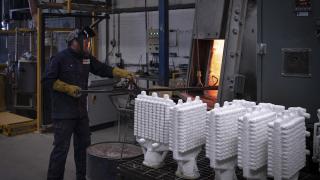
How Investacast helps you find the right solution
In this blog we look at what Waterglass Casting is, and when you might choose to cast your components using this process.
How does Waterglass Casting differ from standard Investment Casting?
There are two elements of the Waterglass Casting process that differ from the standard Investment Casting process.
These are the wax used in making the pattern, and the material used to form the ceramic shell.
Wax used in the Waterglass process
The Investment Casting process starts with the creation of a high quality wax pattern around which a ceramic shell is produced. This shell forms the mould into which liquid metal is poured. Waterglass Casting uses a different type of wax for the pattern, which melts in hot water.
This means that instead of using pressurised steam in an autoclave to remove the wax, the moulds can simply be submerged in hot water. The molten wax floats to the surface and can be skimmed off and re-used.
Waterglass Casting material
Waterglass or ‘Water Glass’ Casting is also known as ‘Sodium Silicate’ Casting, after the additive used as a binder within the ceramic casting shell.
Sodium Silicate was developed in the 1600’s and has many uses in industry. The process of Waterglass Casting originated in Russia and it is now one of the most common Investment Casting processes in China, used in about 75% of its foundries.
In Waterglass Casting, sodium silicate is added to sand to form the ceramic slurry that is then used to produce the ceramic shell mould. High temperature firing of the shell sinters the ceramic elements together to form a high strength shell suitable to receive the molten metal charge. The advantages of adding sodium silicate are:
- It can be used in high temperature moulds (so materials such as iron and SG iron can be cast using this method)
- It dissolves in water so is clean and easy to remove
- It is suitable for shelling for heavy components
Does the Waterglass Casting process look like Investment Casting?
Yes, Waterglass Casting uses the same techniques as Investment Casting – a wax pattern is created from a principal die, then the patterns are attached to a sprue or tree and dipped repeatedly in the shelling material of sand and slurry until the shell is sufficiently robust.
Instead of using an autoclave the wax is melted off in water, then the appropriate metal alloy is poured into the moulds to make the casting.
What are the advantages of Waterglass Casting?
Waterglass Casting has several benefits:
- wax removal is easier
- larger parts can be made as not limited by the size of the autoclave
- suitable for heavier, stronger parts often used in industry sectors such as construction and agriculture
What materials are suitable for Waterglass Casting?
Investacast has strong relationships with overseas foundries who are experienced in this process and provide high quality Waterglass Castings. Your parts can be cast from a variety of materials including steel, iron, nodular cast iron, high chromium iron, high manganese steel, alloy steel and heat-resistant steel.
Waterglass Casting from Investacast
Investacast offers a wide range of production methods for your parts, and is always happy to advise on what is best for your requirements. For a brief guide to the relative benefits and costs of each manufacturing process see our blog on Choosing the Right Production Method, or contact our expert team on +44 (0) 1271 866200 or email [email protected] for more information.